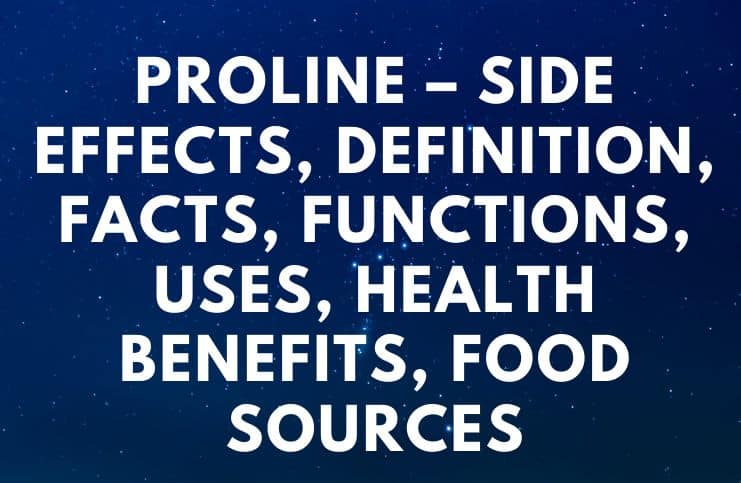Proline – Side Effects, Definition, Facts, Functions, Uses, Health Benefits, Food Sources:
Facts
This is a non-essential amino acid that is synthesized by the body from the non-essential amino acids ornithine or glutamine and is involved in the body’s production of glutamic acid. It is the 3rd most abundant amino acid in the body.
It was first isolated in 1900 by Richard Willstatter, who obtained the amino acid while studying N-Methyl-L-proline.
It is different from other amino acids in that it has another amino group and contains a pyrrole ring (C4H4NH), such as found in hemoglobin and the cytochromes.
This structure causes this amino acid in a protein to impart a rigid protein structure.
Health Benefits
- It is one of the main components of collagen. These collagen fibers are found in the ligaments, tendons, and connective tissues of the body.
- It also promotes the formation of bone, skin, and cartilage, and it is essential for the proper functioning of joints and tendons.
- It helps maintain and strengthen heart muscles and is important in tissue repair after injury or for any type of wound healing.
- It is involved in energy production.
- It can be used to improve and maintain healthy tissue, muscle, and skin and to strengthen heart muscles.
- The body needs this amino acid to maintain muscle tissue as well. A decreased level of this amino acid has been noted in extended endurance marathon runners and others following prolonged exercise.
- It helps strengthen the cardiac muscle.
- Consuming foods rich in this amino acid lowers requirements for arginine, due to the fact that the physical body can transform proline into ornithine and ornithine into arginine.
Dosage
Vitamin C deficiency will cause this amino acid to be lost in the urine because of collagen breakdown. This is an early symptom and precursor of degenerative disease.
The recommended therapeutic dose is between 500 milligrams and 1,000 milligrams/day, in combination with vitamin C.
Food Sources
You can find this amino acid in a variety of foods, such as – meats, dairy products, eggs, cabbage, asparagus, watercress, bamboo shoots, spirulina, wakame, broccoli raab, spinach, chives, red kid hens beans, white beans, adzuki beans, mung beans, lentils, chickpeas, sesame seeds, cotton seeds, sunflower seeds, flaxseeds, chia seeds, pumpkin seeds, hemp seeds, potatoes, sweet potatoes.
Side Effects of Proline
People with liver or kidney disease should not take this amino acid supplement without first consulting their medical specialist.
The intake of supplements containing this amino acid should be restricted to patients who are suffering from hyperprolinemia, a genetic disorder.
Too much proline can give you an elevated amino-acid intake. Also, getting too much of any type of amino acid can throw the citric acid (which has an important role in our metabolism) cycle out of balance, which makes the kidneys and liver work harder to eliminate toxins.
It is not recommended for people who have allergies to supplements that contain this non-essential amino acid.
READ THIS NEXT:
Aspartic Acid – Health Benefits
References https://pubchem.ncbi.nlm.nih.gov/compound/L-Proline https://www.sciencedirect.com/topics/neuroscience/proline
